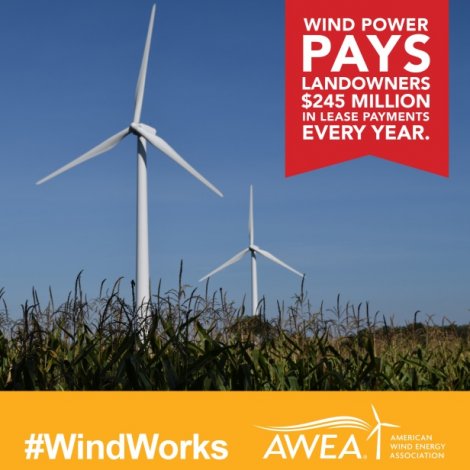5 Ways Rural Communities Can Win with Wind
 | Isak Kvam, Communications / Policy Associate |

 | Isak Kvam, Communications / Policy Associate |
As St. Patrick's Day approaches, you don't have to look for the end of the rainbow to realize that rural communities are lucky to have wind energy. Wind projects bring many benefits to local landowners, schools, businesses, and communities that host them. Wind developers build 99 percent of their projects in rural communities and are eager to ensure residents receive the full benefits a wind farm can bring.
Wind energy brings a new source of tax revenue to counties and townships
Wind projects are multi-million dollar developments that operate within a county, and they contribute a lot of tax revenue to the county and townships they are located in. This new revenue provides relief for small, rural towns, many of which have been financially strapped in recent times.
For example, wind production taxes contributed $2.37 million to Mower County in 2016. “Wind … has been a good thing for Mower County,” said Commission Board Chairman Tim Gabrielson. “Our entire community benefits from the production tax revenue received by our County. This last year, the county board committed $400,000 of the county portion of revenue from the wind energy production tax toward improving roads and bridges. We’ve used the remainder as a tax relief for citizens. Having this new revenue source from wind power reduces the amount of tax dollars that would be needed to be raised from taxpayers to pay for our county operations.”
 Landowners receive lease payments from wind projects
Landowners receive lease payments from wind projects
About one acre of land is all that's needed for the turbine and access roads. The land is leased from consenting landowners, who in turn receive an annual land lease payment for the life of the project. Oftentimes these landowners are farmers, who have embraced wind energy as a new cash crop. Farmers make an honest living producing goods from their land. Harvesting the wind that blows above their crops is no different.
Wind developers work alongside farmers to make sure turbines are located in preferential spots and that access roads to the turbines are constructed in a way that can benefit the farmer. In turn, the farmer receives a stable income from the developer. Farmers can face difficulty in planning the future of their farm operation as commodity prices are always changing. A stable paycheck from a wind company can be just the thing they need to help get through the tough years, and during good times it offers the opportunity to invest in their farm or other needs.
Wind energy creates new jobs & economic development
During construction, hundreds of construction workers are needed. This influx of workers is good news for local hotels, gas stations and restaurants. Local building and construction supply companies such as heavy equipment rental and cement companies also benefit from this development. When the project is complete, the wind project often become a new town employer, creating full-time jobs for wind technicians, site managers, and office staff; as well as providing opportunities for existing service providers, like landscapers and snow plow operators. The economic development continues as companies maintain their fleet of vehicles at the local service station, open corporate accounts at the local hardware store, and use other businesses in the local economy. The wind industry now employs over 100,000 Americans, and wind turbine technician is the fastest growing job in America.
Wind energy funds communities
The companies that own wind projects want to be good corporate citizens. Most wind companies donate directly to local charities, youth clubs, restoration efforts, and projects that benefit the entire community.
Subscribe to our newsletter for the latest on energy & our work
For example, one Minnesota-based developer establishes a community fund for every wind farm that it builds. These are 501(c)(3) organizations that guarantee annual payments to the local community for a 20 year period. Local community members become the fund’s board of directors and decide which local projects to invest in, which may include educational scholarships, grants for local businesses, or helping the local fire department purchase a new fire truck.
Wind energy supports local schools
Many local communities that host wind turbine projects use the new tax revenue to invest in their school district. Funding for public schools come from the local tax base, and wind projects can provide more funding for schools to use as they see fit. Schools may choose to invest in better technology, new academic programs for students, offer higher wages for teachers so that they can attract quality people to provide a better education for their students.
For example, one wind project in Ohio added $400,000 to the school district every year for 20 years. This allowed the school to purchase a computer for every student K-12, and also opened a pre-engineering program and a biomedical program for high school students.
While wind projects do present a big change for small towns, they also offer benefits for everyone – not just the participating landowners. By offering jobs, increased economic development, and new sources of revenue – they truly are a good choice for rural communities to become more self-reliant and resilient. And that leads to a better future for everyone.
Want to learn more about renewable energy? Sign up for our monthly Champions newsletter to get the latest stories and resources about the Midwest's transition to renewable energy.